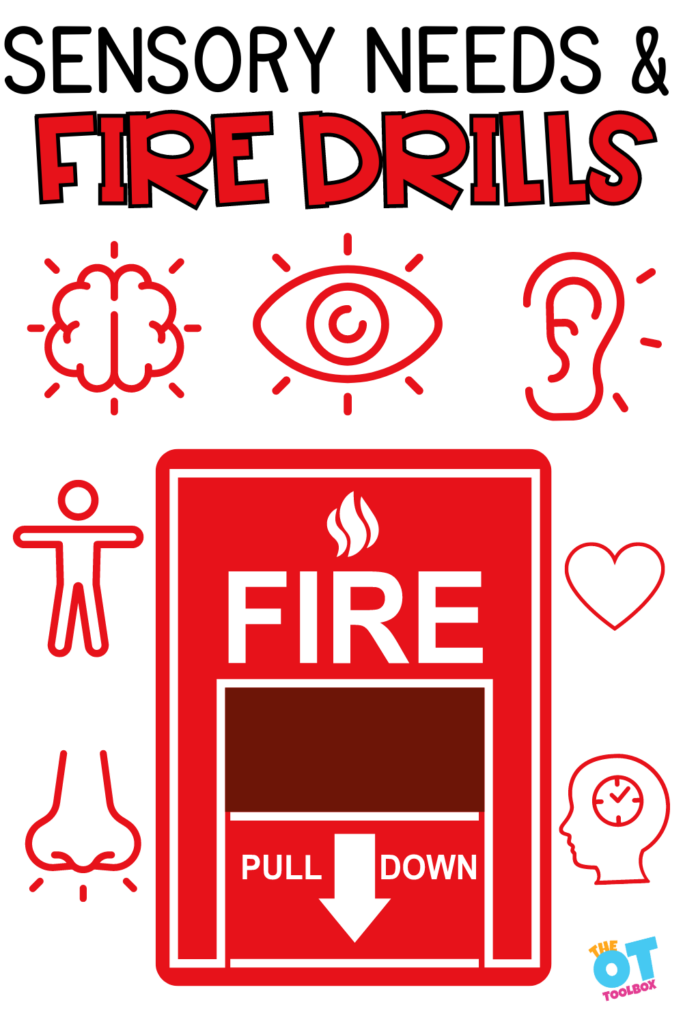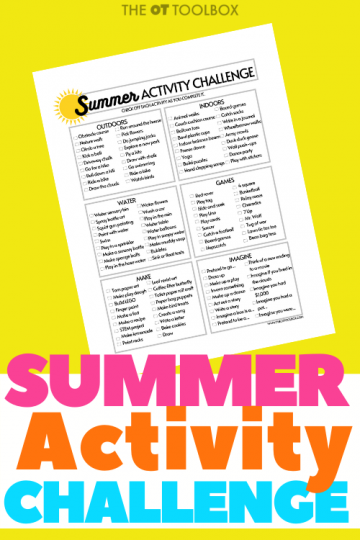Who remembers a childhood fire drill? Did you know that memories are driven by emotions? People remember times or events that trigger emotional responses because of the overwhelming input leads to sensory dysregulation. Luckily having a few strategies in place can help the child with sensory needs navigate a fire drill.

Sensory Processing and Fire Drills
A fire alarm is one of them. If you work in a school system (school based OT or otherwise), you are probably faced with regularly scheduled fire drills. In the southern United States, there are also tornado and earthquake drills. Due to the increasing number of school shootings, a lock down drill has also been implemented.
The sudden sound, moving quickly out of the building, excitement/fear during the event, and an unexpected change in routine during the day, can create a lasting memory for a sensitive person, especially when it comes to auditory sensitivities.
The fire drill does not have to be a traumatic event. In this post we will learn about Navigating the School Fire Drill; including understanding, communicating, and accommodating for sensory processing difficulties.
Navigating the School Fire Drill
Fire alarms are not isolated to school buildings. While teaching a seminar last year in a large hotel, the fire alarm went off. This brought up old feelings and memories as people rushed out of the building to gather near the tree outside of the building. There was no protocol to gather by the tree, however, old habits die hard! The adults were able to fairly quickly resume class after the fire alarm was resolved, however, some people were shaken. A person with sensory processing disorder can be out of sync for several minutes, or the rest of the day. For example, autism and loud noises can impact the rest of the day. Keeping this in mind, caregivers can help the transition go smoothly during and after the alarm.
While this post focuses on navigating the school fire drill or alarm, the information can easily transfer to anywhere there might be an alarm.
Today’s post comes from an excerpt from my book, Seeing your Home and Community with Sensory Eyes. It is a comprehensive guide to helping yourself or others navigate different environments. I broke it down into chapters for ease of scanning to find the relevant information. Ultimately, the book answers the question, “why do they do that?”
There are three steps you can implement when working on helping someone with sensory difficulties (or typical people who need to learn to prepare for something new). Understanding, communicating, and accommodating are great strategies.
Fire Drills and Sensory Processing
The first step to repair and remediate the sensory reaction and response is to understand what is going on when trying to navigate the school fire drill.
Almost all your senses can be triggered during a fire alarm:
- Visual: flashing lights, disorganized movements, lots of people rushing down the hall or stairs, many children and adults moving at the same time, fire truck, and fire fighters. It is especially difficult to process all of this concurrent visual information, as there is an expectation to move quickly.
- Auditory: alarm buzzing or beeping, children and adults talking, children crying, fire trucks, opening and closing doors, shuffling feet, and moving furniture. Sudden unexpected sounds and disorganized sounds happening at the same time creates auditory chaos.
- Tactile: several people close together, who might bump into each other, the difference in air temperature from indoors to outside, quickly donning coat or hat, or bumping into parts of the building. In a tornado drill students sit in the hallway with their head tucked down, or under a mat or desk. Sitting under a desk can be especially confining to a sensitive person.
- Proprioception: sudden disorganization can cause a decrease in body awareness. A person may trip over his feet, fall on the stairs, bump into people, get too close, push people out of the way, or stumble. In a tornado drill students sit close together, under a desk or mat, tucked into a ball, or against the wall. This feels overwhelming to a sensory avoider. The amount of activity can be stimulating and exciting to a seeker.
- Vestibular: child may become disoriented by the sudden movement, walking down the stairs, and quickly navigating the building. Sounds and other incoming information can increase vestibular disorganization.
- Olfactory: the close proximity of many people, or fire/smoke odors if there is an actual fire. Not being able to get away from smells can feel overwhelming to a person who is sensitive.
- Emotions: Maladaptive behavioral reactions can be caused by: fear, anxiety, excitement, clumsiness, impulsivity, lack of control, difficulty following directions, difficulty processing what is being said, shut down, or defiance can cause maladaptive behavioral reactions. The emotions are often the first outward signal of distress.
All of the sensory input happening during this time is especially a challenge because for the child with sensory processing needs, or regulation needs, this is very sudden input. Sometimes teachers know that the drill is going to happen and other times they don’t. We need to keep our kiddos safe during this time but the onslaught of input can be very distressing for some of our students.
We see a hit to the limbic system, the sensory system receives sensory messages, like the shrill fire drill sound, and directs them to the part of the brain that needs to process it to keep us safe. The sudden sensory input can trigger an automatic safety response called a ‘fight, flight or freeze’ response. We might see all kinds of sensory responses as a result.
COMMUNICATION
The second step to seeing the community through “sensory eyes” and navigating the school fire drills, is learning to communicate about sensory preferences, how things look and feel, and what can be done to make life easier to navigate. When you think about all of the visual input happening during a fire drill, it can be a lot for those with sensory needs.
There is visual noise in the way of students and classrooms rushing to their designated safe space. There are a lot of moving pieces happening all at once. Sometimes a simple conversation can ease the anxiety and set the stage for new or difficult situations.
conversations about the fire alarm
The loud fire alarm sound can be very distressing. Having a conversation about the fire alarm can help.
This is what a conversation about the fire alarm might sound like
“There are times when the fire alarm will go off. Sometimes it will be a drill. Let me explain what this is. In the event of a real emergency, we need to know what to do, so we will practice first. The fire alarm is very loud. It lets us know there is an emergency, and we will need to move quickly. When you hear the alarm, get out of your seat, and make a line at the door. We will go down the hallway, down the stairs, out the back door, and stand by the tree at the far end of the parking lot. I will count and make sure we are all here.
we can go back inside after the drill or emergency is finished. There will be a fire truck and fire fighters. They are here to help us. If it is a drill, there is no emergency, just a practice. The fire fighters will talk to the principal and we can go back inside. If it is an emergency, they will do their job to make sure the building is safe before we go back in.
It is important to follow directions and stay together. Let everyone do their job and remember each person has a different job to do. Focus on your own job. What is your job during a fire alarm?
If everyone follows directions, it will go quickly and smoothly.”
Ask Students Questions about Fire Drills
These are some questions you can ask to understand the fire drill better:
(You can modify or eliminate some questions depending on the audience)
- How do you feel about the upcoming fire drill after hearing about it?
- Do you remember other fire drills, or is this the first?
- How did you feel after going to the fire drill?
- Were you scared the noise the alarm made?
- Were you able to follow directions and listen?
- Was it exciting doing something new and different?
- Do you have questions about why there is a fire drill?
- How did you know it was a drill and not an emergency?
- What do you do differently in a real emergency? Answer: nothing. Treat a drill the same as a real emergency.
- Did anyone cry during the drill? What can you do to be a good friend?
- If the sound of the alarm bothers you, what can you do?
How to Accommodate for Fire Drills
The third step in navigating the school fire drill involves making accommodations to assist people with or without sensory processing disorder participate in the event easier, and with less distress. As with most sensory adaptations, it is a lot of trial and error to determine what the right combination is for each of your students.
- Provide ear protectors for sensitive children. This will lessen the sound, allowing them to focus on the instructions. In the middle of a fire alarm (rather than a planned drill), this may not be the best option due to timing. In this case, allow child to hold hands over his ears.
- Use the buddy system; children who are not bothered by the fire alarm can assist the more sensitive children. Children like being in charge, and a struggling student can have a good example to model.
- Stand near children, or hold their hand, to insure they are not stumbling or falling.
- Place sensitive children near the back of the line so they do not feel overwhelmed by being so close to other children.
- Use a guide rope to help guide small children. Each child holds onto a portion of the rope. This keeps them in a line and gives a specific place to be.
- Have strollers or a wagon ready for children who cannot safely navigate out of the building. Sometimes slow moving children are even slower when faced with a stressor.
- Reassure children throughout the alarm, while continuing to provide information about what is happening. Sometimes not knowing what is happening is worse than knowing.
- Provide a calm and quiet environment after the event is over. Dimmed lighting, quiet reading, small group, or independent play can help restore equilibrium after an event such as a fire drill.
- Use a toolbox of coping strategies.
- Use noise cancelling headphones for sensory intolerance
- Use earplugs for sensory overload
Real Life Examples on Fire Drills and Autism
Sometimes you can see the behavior but not untangle why they are behaving a certain way. Here are some examples you might see when navigating the school fire drill
The child or person:
- shuts down and will not move. The sudden noise has set up a flight, flight, or freeze reaction. The child is unable to make decisions, follow instructions, or move. Solution: physically help the child move out of the building.
- is out of control. The alarm has triggered a fight or flight response. Solution: help the child physically to move through the building while reassuring him.
- is loud or making strange noises. The child is trying to drown out the sound of the alarm with his own sounds. This is a normal reaction for a person with auditory sensitivity. Solution: allow humming during this loud experience or provide alternatives such as ear plugs, covering the ears, or headphones.
- covers his ears. The sound is loud and feels deafening to a sensitive person. While it makes sense for a child to use their hands to steady themselves or grab a teacher, covering the ears is a natural reaction and should be allowed, unless an alternative is provided.
- stumbles and falls. The child has diminished body awareness because they are focused on the sound of the alarm. Solution: physically help guide the child down the hall and out the door to avoid an accident. Focus on body awareness.
- bumps and pushes others. Fight or flight reaction triggers the child to need to get people out of the way. The child may have lost awareness of his body position in relation to others due to the sound and chaos. Sometimes people do not realize they are pushing others. When someone may have accidentally brushed up against them, a sensitive person may respond as if they have been attacked. Solution: physically help guide the child out of the building. You can also focus on turn taking in hallways.
- cries for a prolonged period after the alarm. The after effects of an event such as a fire drill can last the rest of the day, or longer. Solution: provide calming techniques after the alarm, structured time during the rest of the day, dimmed lighting, and a quiet classroom environment to allow the child’s sensory system to re-acclimate.
What are some other strategies for navigating the school fire drill?
- Social stories for a fire drill- A social story about a fire drill can help. Include information related to the student and the school.
- Fire Safety activities are easy to use as traditional classroom lesson plans, centers, homework, independent work, or they’re great for fast finishers in first and second grades.
- Fire safety activities- Try activities on Firefighters, Fire Safety, and Classroom Fire Drill Procedures to help your students know the importance of practicing fire drills, what to do in case of a fire, and not be afraid of fire fighters!
- Fire prevention week – this website has a lot of resources for learning about fire safety
- Seeing your Home and Community with Sensory Eyes – This manual is a valuable tool for understanding and effectively communicating with those affected by sensory processing disorder. This guide can assist caregivers, individuals, families, therapists, and teachers untangle the web of senses to give correct guidance and assistance. You can read this guide cover to cover for optimal learning, or by selecting chapters as needed.
- The Sensory Lifestyle Handbook – The Sensory Lifestyle Handbook is your strategy guide for turning sensory diets and sensory activities into a sensory lifestyle.
- The Sensory Processing Disorder Handbook – This 26 page guide explains SPD in easy-to-understand terms
- A fire drill song might be helpful for some kids:
- This video on fire drills is helpful:
Fire Alarm and Sensory
Adults can be triggered by sensory input the same as children. Do not discount the feelings of others in the building, or making your own needs known. It is amazing the things we remember from our childhood. Who remembers Stop Drop and Roll? I remember practicing this and feeling terrified that I might actually catch on fire one day. As a young parent, thinking about my own children being trapped in our house during a fire elicited some strong emotions. We prepared at home for any emergency and practiced as well.
Do you think it is right to let teachers and staff know when the fire drill is planned? While this helps them prepare for the drill ahead of time and make accommodations, it ruins the element of surprise that would happen in the event of a real fire. Planning and practicing are great ideas, however maybe there needs to be a couple of surprise drills thrown in the mix to simulate a real life emergency. Something to think about.

Victoria Wood, OTR/L is a contributor to The OT Toolbox and has been providing Occupational Therapy treatment in pediatrics for more than 25 years. She has practiced in hospital settings (inpatient, outpatient, NICU, PICU), school systems, and outpatient clinics in several states. She has treated hundreds of children with various sensory processing dysfunction in the areas of behavior, gross/fine motor skills, social skills and self-care. Ms. Wood has also been a featured speaker at seminars, webinars, and school staff development training. She is the author of Seeing your Home and Community with Sensory Eyes.






